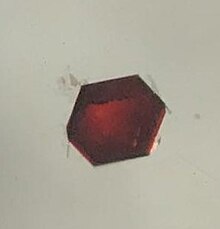
| |

| |
| Names | |
|---|---|
| IUPAC name Bis(η-cyclooctatetraenyl)plutonium(IV) | |
| Other names
Plutonium cyclooctatetraenide Pu(COT)2 | |
| Identifiers | |
| CAS Number | |
| 3D model (JSmol) | |
| PubChem CID | |
InChI
| |
SMILES
| |
| Properties | |
| Chemical formula | C16H16Pu |
| Molar mass | 452 g·mol |
| Appearance | cherry red crystals |
| Solubility in water | insoluble, does not react with water |
| Solubility in chlorocarbons | sparingly soluble (ca. 0.5 g/L) |
| Hazards | |
| Occupational safety and health (OHS/OSH): | |
| Main hazards | radiation hazard, pyrophoric, toxic |
| Except where otherwise noted, data are given for materials in their standard state (at 25 °C , 100 kPa). Infobox references | |
Plutonocene, Pu(C8H8)2, is an organoplutonium compound composed of a plutonium atom sandwiched between two cyclooctatetraenide (COT) rings. It is a dark red, very air-sensitive solid that is sparingly soluble in toluene and chlorocarbons. Plutonocene is a member of the actinocene family of metallocenes incorporating actinide elements in the +4 oxidation state.
Compared to other actinocenes such as uranocene, plutonocene has been studied to a lesser degree since the 1980s due to the notable radiation hazard posed by the compound. Instead, it has mostly been the subject of theoretical studies relating to the bonding in the molecule.
Structure and bonding
The compound has been structurally characterised by single crystal XRD. The cyclooctatetraenide rings are eclipsed and assume a planar conformation with 8 equivalent C–C bonds of 1.41 Å length; the molecule possesses a centre of inversion at the position occupied by the plutonium atom. The Pu–COT distance (to the ring centroid) is 1.90 Å and the individual Pu–C distances are in the 2.63–2.64 Å range.
Despite the similarity in molecular structures, plutonocene crystals are not isomorphous to other actinocenes, as plutonocene crystallises in the monoclinic I2/m space group whereas thorocene, protactinocene, uranocene and neptunocene all crystallise as monoclinic P21/n.
Theoretical calculations utilising various computational chemistry methods support the existence of an enhanced covalent character in plutonocene from the interaction of Pu 6d and 5f atomic orbitals with ligand-based π orbitals.
Synthesis
Plutonocene was first synthesized in 1970 form the reaction of tetraethylammonium hexachloroplutonate(IV) (2PuCl6) with dipotassium cyclooctatetraenide (K2(C8H8)) in THF at room temperature:
- (NEt4)2PuCl6 + 2 K2(C8H8) → Pu(C8H8)2 + 2 NEt4Cl + 4 KCl
This approach is different compared to the synthesis of other actinocenes which usually involves the reaction of the actinide tetrachloride AnCl4 with K2(C8H8); this is not possible in the case of plutonium, as no stable plutonium(IV) chloride species is known. The reaction also does not work when using the caesium or pyridinium hexachloroplutonate(IV) salts in the place of the tetraethylammonium one.
A more recent synthesis involves 1 e oxidation of the green salt with AgI:
- + AgI → Pu(C8H8)2 + Ag + I
The anion is obtained via ligand substitution from K2(C8H8) and other organoplutonium(III) complexes, which can be ultimately derived from reduction of the more common PuO2 with HBr in THF. Pu halides PuCl3 and PuI3 have also been used as the plutonium starting material.
Other properties
The product is chemically analogous to uranocene and neptunocene, and they practically exhibit identical chemical reactivity. All three compounds are insensitive to water or dilute aqueous base, but are air-sensitive and react quickly to form oxides. They are only slightly soluble (with saturation concentrations of about 10 M) in aromatic or chlorinated solvents such as benzene, toluene, carbon tetrachloride or chloroform.
References
- ^ Karraker, David G.; Stone, John Austin; Jones, Erwin Rudolph; Edelstein, Norman (1970-08-01). "Bis(cyclooctatetraenyl)neptunium(IV) and bis(cyclooctatetraenyl)plutonium(IV)". Journal of the American Chemical Society. 92 (16): 4841–4845. doi:10.1021/ja00719a014. ISSN 0002-7863.
- ^ Greenwood, Norman N.; Earnshaw, Alan (1997). Chemistry of the Elements (2nd ed.). Boston, Mass.: Butterworth-Heinemann. pp. 1278–1280. ISBN 978-0-08-037941-8.
- ^ Windorff, Cory J.; Sperling, Joseph M.; Albrecht-Schönzart, Thomas E.; Bai, Zhuanling; Evans, William J.; Gaiser, Alyssa N.; Gaunt, Andrew J.; Goodwin, Conrad A. P.; Hobart, David E.; Huffman, Zachary K.; Huh, Daniel N. (2020-09-21). "A Single Small-Scale Plutonium Redox Reaction System Yields Three Crystallographically-Characterizable Organoplutonium Complexes". Inorganic Chemistry. 59 (18): 13301–13314. doi:10.1021/acs.inorgchem.0c01671. ISSN 0020-1669. OSTI 1680020. PMID 32910649. S2CID 221623763.
- ^ Apostolidis, Christos; Walter, Olaf; Vogt, Jochen; Liebing, Phil; Maron, Laurent; Edelmann, Frank T. (2017). "A Structurally Characterized Organometallic Plutonium(IV) Complex". Angewandte Chemie International Edition. 56 (18): 5066–5070. doi:10.1002/anie.201701858. ISSN 1521-3773. PMC 5485009. PMID 28371148.
- ^ Kerridge, Andrew (2013-11-06). "Oxidation state and covalency in f-element metallocenes (M = Ce, Th, Pu): a combined CASSCF and topological study". Dalton Transactions. 42 (46): 16428–16436. doi:10.1039/C3DT52279B. ISSN 1477-9234. PMID 24072035.
| Plutonium compounds | |
|---|---|
| Plutonium(II) | |
| Plutonium(III) | |
| Plutonium(IV) | |
| Plutonium(V) | |
| Plutonium(VI) | |
| Plutonium(VIII) | |